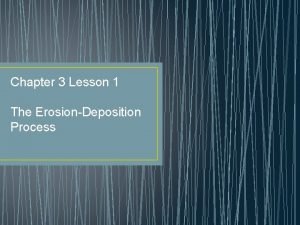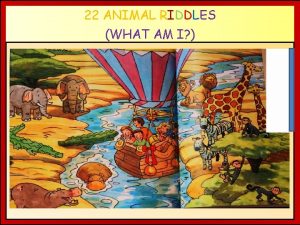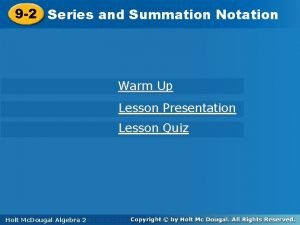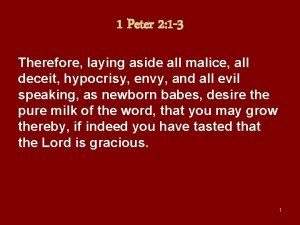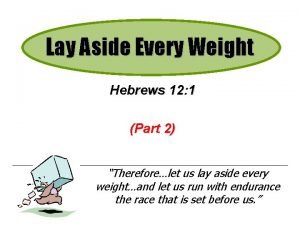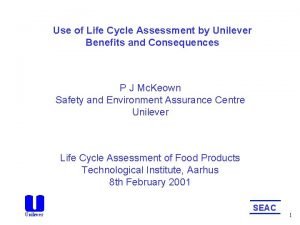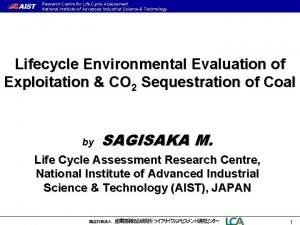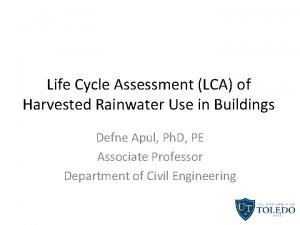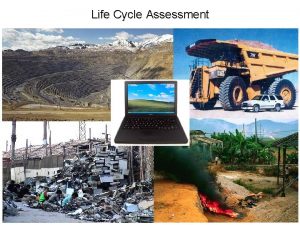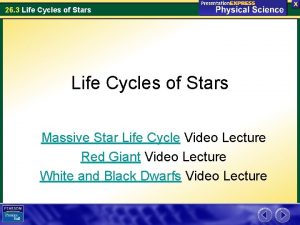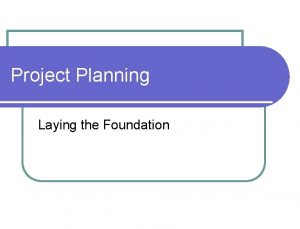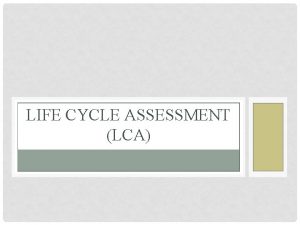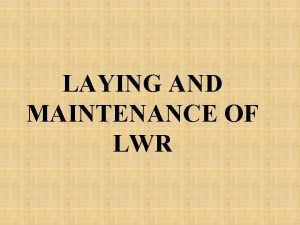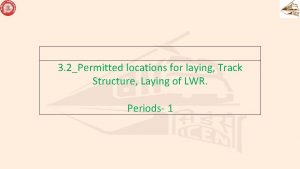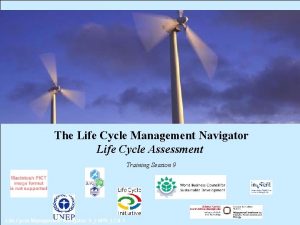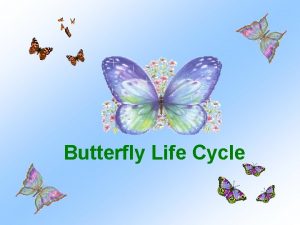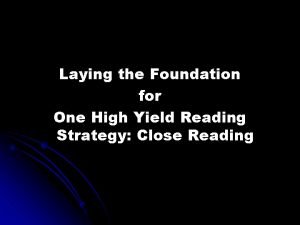Life Cycle Assessment Laying the Foundation for a























- Slides: 23

Life Cycle Assessment: Laying the Foundation for a Transparent Supply Chain Shopping Bag Case Study September 26, 2013 Dr. Anahita Williamson Director Kate Winnebeck LCACP, Senior EHS Specialist New York State Pollution Prevention Institute at RIT

Life Cycle Assessment (LCA) is a technique used to quantify the environmental impact of a product from raw material acquisition through end of life disposition (cradle-to-grave) Material Extraction Processing Component Fabrication Product Assembly Packaging & Distribution Use End of Use Processing Reuse Remanufacture Recycle Waste Treatment

LCA Methodology • A Life Cycle Assessment is carried out in four distinct phases: (ISO 14040, 14044) – Step 1: Goal definition and scoping. Identify the LCA's purpose, the products of the study, and determine the boundaries. (what is and is not included in the study) – Step 2: Life-cycle inventory. Quantify the energy and raw material inputs and environmental releases associated with each life cycle phase. – Step 3: Impact analysis. Assess the impacts on human health and the environment. – Step 4: Report results. Evaluate opportunities to reduce energy, material inputs, or environmental impacts at each stage of the product life-cycle.

Step 1: Goal Definition and Scoping Define the goal: – Intended application of the study – Intended audience Define the scope: – – – Identify the product system to be studied Define the functional unit Define the boundaries of the product system Identify assumptions and limitations of the study Select impact categories to be included

Today’s Example • You own a grocery store and customers are starting to request that you sell reusable shopping bags. You are curious which type of bag has the lowest environmental impact. In order to quantify and compare the bag options, a streamlined LCA is performed. • Goal: – Determine which grocery bag – single use paper, single use plastic, reusable plastic, or reusable cotton – has the lowest environmental impact Sustainability Victoria, Comparison of existing life cycle analysis of shopping bag alternatives, Apr 07.

Draw the System Boundaries • Assumptions: – – All bags are manufactured 100 km from the customer All bags travel 10 km from the customer to the end of life Half of paper bags are recycled at end of life, half go to landfill Plastic & cotton bags go to landfill at end of life 1. As a group, draw the boundaries or process flow of the system

System Boundaries Material Extraction Bag Manufacture Packaging & Distribution Use End of Life Transform petroleum into plastic Form plastic into bags Packaging & Distribution Use Landfill Transform trees into paper Form paper into bags Packaging & Distribution Use 50/50 to Landfill & Recycling Processing Single use & reusable plastic bag Extracting petroleum Paper bag Cutting down trees

Functional Unit • The functional unit is a measure of the function of the studied system – Provides a reference to which the inputs and outputs can be related – Enables comparison of two essentially different systems • Examples – The functional unit for a paint system may be defined as the unit surface protected for 10 years – The functional unit for a printer may be defined as the number of printed pages of an acceptable print quality – The functional unit for power generation systems may be defined as 1 k. Wh of electricity

Functional Unit The amount of shopping bags consumed by a household to carry 70 grocery items home from the supermarket each week for 52 weeks Bag Type Single use plastic Single use paper Reusable plastic Reusable cotton Material HDPE Unbleached Kraft paper Polypropylene Cotton Mass per bag 7 g 42. 6 g 95 g 85 g Relative Capacity 1 0. 9 1. 1 Bags per Year 520 578 4. 55 Mass bags per year 3640 g 24622. 8 g 432. 25 g 386. 75 g

Step 2: Life Cycle Inventory • Highly data intensive • Detailed mass & energy balances performed over life-cycle • Advantages: measure data & define baseline metrics of life -cycle processes • Challenges: Assumptions made when data unavailable

Step 2: Life Cycle Inventory collected from multiple sources Inputs Energy database Raw Materials Outputs Manufacturing Products Distribution Customer use End of use processing Air, Water and Solid Emissions

Toner Life-cycle Inventory Ref: A. Ahmadi, et. al, J. Clean. Prod. , 2003

Toner Life-cycle Inventory Ref: A. Ahmadi, et. al, J. Clean. Prod. , 2003

Impact Assessment Results • Impact assessment converts the inventory into impact categories or end points which details the human health and environmental effects.

High Density Polyethylene Inventory Peer reviewed datasets imbedded in software Data has been collected by others and represents actual operations Include: • Known inputs • Emissions to air • Emissions to water • Emissions to soil • Wastes and emissions sent to treatment Ability to modify datasets based on your own data 2. As a group, choose one of the four bags and list the processes that are included in the inventory

Life Cycle Inventory Single Use Plastic Bag Polyethylene, HDPE, granulate Stretch blow moulding Transport, 100 km manufacturing to customer Transport, municipal waste collection, 10 km customer to landfill Disposal, polyethylene, 0. 4% water, to sanitary landfill Single Use Paper Bag Kraft paper, unbleached, at plant Production of paper bags Transport, 100 km manufacturing to customer Transport, municipal waste collection, 10 km customer to landfill/recycling Disposal, packaging paper, to sanitary landfill Recycling paper 3640 g 0. 364 tkm 0. 0364 tkm 3640 g 24622. 8 g 2. 4623 tkm 0. 24623 tkm 12311 g Reusable Plastic Bag Polypropylene, granulate Extrusion, plastic film Transport, 100 km manufacturing to customer Transport, municipal waste collection, 10 km customer to landfill Disposal, polypropylene, to sanitary landfill Reusable Cotton Bag Textile, woven cotton, at plant Transport, 100 km manufacturing to customer Transport, municipal waste collection, 10 km customer to landfill Disposal, inert material, to sanitary landfill 432. 25 g 0. 043225 tkm 0. 0043225 tkm 432. 25 g 386. 75 g 0. 03867 tkm 0. 0038675 tkm 386. 75 g

Step 3: Impact Assessment • Converts the inventory into impact categories or mid/end points which explain the environmental effect • Impact categories may include: carcinogens, respiratory organics and inorganics, climate change, radiation, ozone layer, ecotoxicity, acidification/eutrophication, land use, minerals, fossil fuels • Can apply weights to impact categories

Impact Assessment Life Cycle Inventory Impact Categories Category Indicators NOx SOx Pesticides Heavy metals CO 2 Concentration in air, water, food Concentration greenhouse gases Changed p. H and nutrient availability Local effects on species Climate change Ozone layer depletion VOCs Particulates Chemicals Change in habitat Fossil fuel availability Fate analysis Damage Categories Radiation Respiratory effects Cancer cases and types Surplus energy Exposure & effect analysis Damage analysis Single Score Indicator Human Health Ecosystem Quality Mineral & Fossil Resources Normalization & weighting

Total Normalized Impact

Normalized Environmental Impact

Step 4: Report Results • Life cycle interpretation: findings of the inventory analysis or impact assessment are evaluated in relation to the goal and scope of the study to reach conclusions and recommendations 1. Identify significant issues 2. Evaluate results for completeness, consistency, and sensitivity of the data 3. Draw conclusions & make recommendations consistent with the goal & scope of the study

Interpreting Results • Which bag has the lowest environmental impact? Which bag has the highest? • Let’s consider cost of the bags. Bag Type Single use plastic Single use paper Reusable plastic Reusable cotton Material HDPE Unbleached Kraft paper Polypropylene Cotton Cost per bag $0. 02 $0. 07 $1 $6 Cost per year $10. 40 $40. 46 $4. 55 $27. 30 • As the store owner, does the cost information change which type of bag you would promote? How? • As a shopper, does the cost information change which type of bag you would use? How?

Anahita Williamson, Ph. D Director Email: anahita. williamson@rit. edu Phone: 585 -475 -4561 Kate Winnebeck, LCACP Sr. Environmental Health & Safety Specialist Email: kate. winnebeck@rit. edu Phone: 585 -475 -5390 New York State Pollution Prevention Institute http: //www. nysp 2 i. rit. edu
 Laying the foundation for a quality culture
Laying the foundation for a quality culture The laying down or settling of eroded material.
The laying down or settling of eroded material. I am small i have feathers i lay eggs i can sing and fly
I am small i have feathers i lay eggs i can sing and fly Laying the table cloth
Laying the table cloth Expand and evaluate sigma notation
Expand and evaluate sigma notation Laying on table
Laying on table Egg laying animals
Egg laying animals Lay aside all malice
Lay aside all malice Let us lay aside every weight
Let us lay aside every weight You have 100 coins laying flat on a table
You have 100 coins laying flat on a table Pile foundation details
Pile foundation details Composition of urine slideshare
Composition of urine slideshare Whole building life cycle assessment wblca
Whole building life cycle assessment wblca Unilever benefits
Unilever benefits Life cycle assessment
Life cycle assessment Life cycle assessment of rainwater harvesting
Life cycle assessment of rainwater harvesting Life cycle assessment
Life cycle assessment Section 26.3 life cycles of stars
Section 26.3 life cycles of stars Gplms
Gplms Fspos
Fspos Novell typiska drag
Novell typiska drag Tack för att ni lyssnade bild
Tack för att ni lyssnade bild Ekologiskt fotavtryck
Ekologiskt fotavtryck Varför kallas perioden 1918-1939 för mellankrigstiden
Varför kallas perioden 1918-1939 för mellankrigstiden

